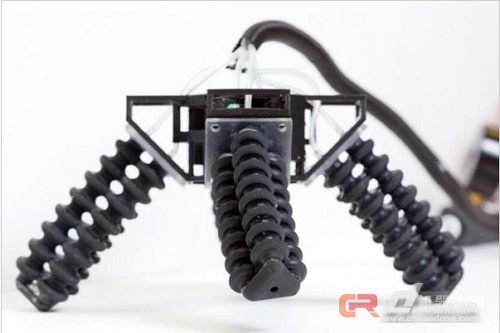A few years ago at the International Conference on Intelligent Robots and Systems (IROS), Harvard graduate student Michael Tolley introduced us to a robot that bounces off explosive power. This pink, soft robot has three legs that can swing side-by-side and are responsible for positioning, but this guy's looks are so sorry for the audience. Tolley now has his own robotics lab at the University of California, San Diego. The main task of the lab is to find an effective way to create software robots. In the latest paper (published next week at ICRA), Tolley showed a walking quadruped robot.

Software robots (equipped with actuators) have great potential, they are cheap, flexible, and easy to configure. However, with the current level of technology, software robots can be unsatisfactory because you must manually complete a series of complex operations.
Dylan Drotman and the Tolley Lab students completed the leg design of the software robot. With the 3D printer, you can print your legs in one shot. In fact, you can even print the entire quadruped robot easily.
Of course, not all 3D printers can meet the requirements. You need a machine that can print soft and hard hybrid materials. Only in this way can the final product have adjustable flexibility. Here, the researchers used the Stratasys Objet350Connex3 printer, but this device is not what the average person can afford.
Each leg of the soft body robot is made of three retractable inflatable rubber tubes. The area of ​​the inflatable rubber tube in contact with the ground is triangular. In operation, you only need to inflate the two hoses on one leg. This leg bends towards the uninflated tube so that you have four soft legs with controllable two axes.
The four legs are connected together in an X-shape, and the inflator or air leak allows the robot to walk (it can be completely different from crawling). The robot can lift the leg, move it and complete the forward movement. With its soft properties, researchers can successfully complete out-of-sync tests and optimize the robot's actions under different road conditions (rock, sandpaper, or caverns).
At the same time, this soft little guy is able to stand upright with a load of 0.62 kg. If he is standing in the beginning, he can take a heavier burden. The load is very important for software robots. It not only can carry useful small devices such as sensors, but also can be modified to achieve new functions. At the moment, pneumatic robots on the market almost have to carry multiple actuators, and at the same time there must be no shortage of compressed air, batteries, and electronic equipment to maintain their movement.
Of course, solving these challenges is not the main purpose of the study, but the author would like to know if the researcher needs to make efforts to bring the robot to market. The use of software robots is easy to guess. The researchers wanted to create a perfect quadruped that can perform monitoring and read relevant sensor data in environments where humans cannot enter.
Digital Signage for office
digital signage for office
Jumei Video(Shenzhen)Co.,Ltd , https://www.jmsxdisplay.com